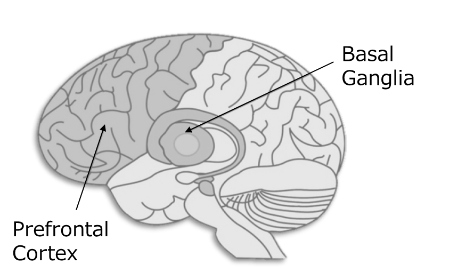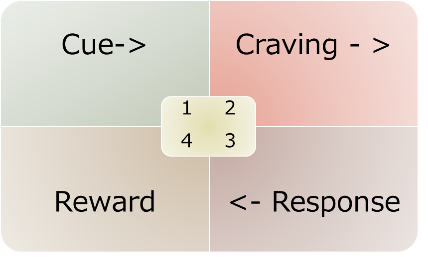To have optimal wellbeing we are constantly reminded to socialise, eat a healthy diet, sleep 7 – 9 hours a day, take breaks throughout the day and exercise all while working in a busy veterinary practice! Yeah right!
You have no doubt heard all the statistics and are well aware veterinary staff are at an increased risk of burn out, mental health issues and suicide. There is no doubt the work comes with inherent stresses but that does not mean you need to go down the path of becoming one of the statistics.
By being proactive and preparing your mind and body with healthy habits you CAN work and thrive in a veterinary practice.
So here is the secret…or, in reality, the science to developing those healthy habits. Be warned it will take time and conscious effort, but if you follow through your brain can not help but create proactive healthy habits for wellbeing.
The Brain

In simple terms creating and embedding habits occurs in two parts of the brain: The Prefrontal Cortex (PFC) and the Basal Ganglia (BG).
The PFC is where executive functions occur i.e. decision making and planning. The BG is the automation centre and looks after emotions, memories, and pattern recognition.
In the early stages of forming habits we need to plan and make conscious decisions using the PFC. The more we repeat the behaviour the BG starts to chunk the activity and it becomes automated in response to a specific cue. How many times have you prepped an animal for surgery and lose count of how many preps you have done or don’t even recall doing it! That is the BG at work chunking the process of clipping the animal and doing multiple scrubs and alcohol wipes as a single activity. In fact, approximately 40 % of what we do in a day is by habit.[1]

The Habit Loop
Habits are simply an automatic response to a specific situation and, according to renowned habits author James Clear, occur as a four-part process. [2]
Cue:
Cue is a stimulus that triggers a specific behaviour. When creating habits, the obvious cue is time or location. i.e. ‘at 8. 00am each day I will…’. The more routine we can build in the quicker the habit becomes automated.
Craving:
Craving is the motivator or anticipation for the expected reward. The craving gets stronger with repetition of the habit and the satisfaction of reward. This becomes the automated driving force to do the habit. In the early stages to establish craving pair the new habit with something you already enjoy. Make it attractive.
Response:
Response is the actual behaviour or action you want to create e.g. taking a lunch break each day at work…we all know we need one! When starting out this will take conscious thought and planning to remove obstacles and resistance to make it easy. The easier you make it the more likely you will succeed.
Reward:
Reward is the ultimate and satisfying goal. If we think back to our response of taking a lunch break each day the goal is not just to eat lunch it is to ultimately contribute to our overall wellbeing and the person we want to be. If we take the time to rest (physically and mentally, no eating at the computer!), eat healthy food, and socialise with others our mind and body will be better prepared to engage with the profession we love.
4 simple laws to follow when making new healthy habits
1. How can I make it obvious? (Cue)
2. How can I make it attractive? (Craving)
3. How can I make it easy? (Response)
4. How can I make it satisfying? (Reward)
Make your habits about the person you want to be and the life you want to live.

Suzie McLean
BPsych (Hons) MAP (Organisational); CertIV VN
Suzie is a qualified Veterinary Nurse and registered Psychologist.
Suzie worked as a Veterinary nurse for close to 20 years prior to returning to study and becoming a Psychologist. Suzie’s career change to Psychology was to affect positive change in the wellbeing of veterinary staff at an individual and organisational level. As a private organisational psychology consultant, Suzie partners with organisations and individuals to maximise wellbeing and productivity.
References:
- [1]Neal, D.T., Wood, W., & Quinn, J.M. (2006). Habits – A repeat performance. Association for Psychological Science (15,4), 198-201.
- [2] Clear, J. (2018). Atomic habits: Tiny changes, remarkable results: an easy & proven way to build good habits & break bad ones. New York: Avery, an imprint of Penguin Random House.
Further Wellbeing Reading:
Atomic Habits by James Clear. Tiny changes, remarkable results: an easy & proven way to build good habits & break bad ones.
Positivity by Barbara Fredrickson. Groundbreaking research reveals how to embrace the hidden strength of positive emotions, overcome negativity, and thrive.
Together by Vivek H. Murthy. The healing power of human connection in a sometimes-lonely world
The third space by Adam Fraser. Using life’s little transitions to find balance and happiness.
